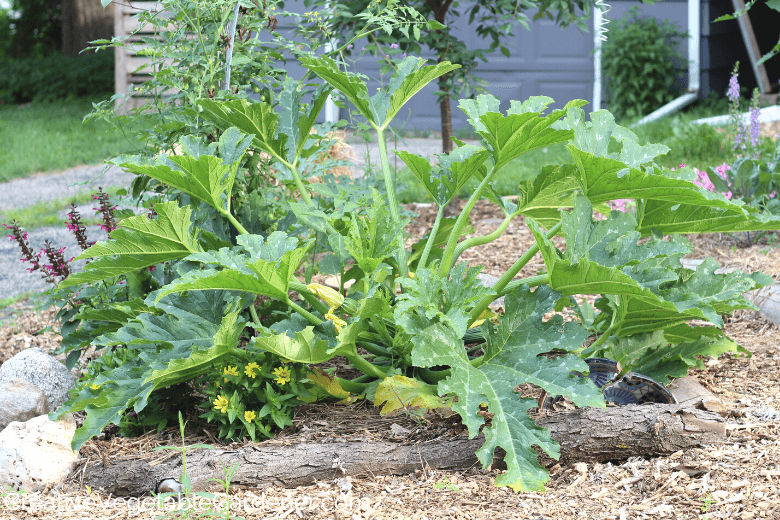If you’re new to gardening and looking to grow some delicious zucchini, a raised bed is the perfect option for you. In this beginner’s guide, you’ll learn all the essentials of growing zucchini in a raised bed. From preparing the soil and selecting the right variety to planting, watering, and caring for your plants, we’ve got you covered. So roll up your sleeves, grab your gardening tools, and get ready to enjoy a bountiful harvest of fresh zucchini right from your own backyard.
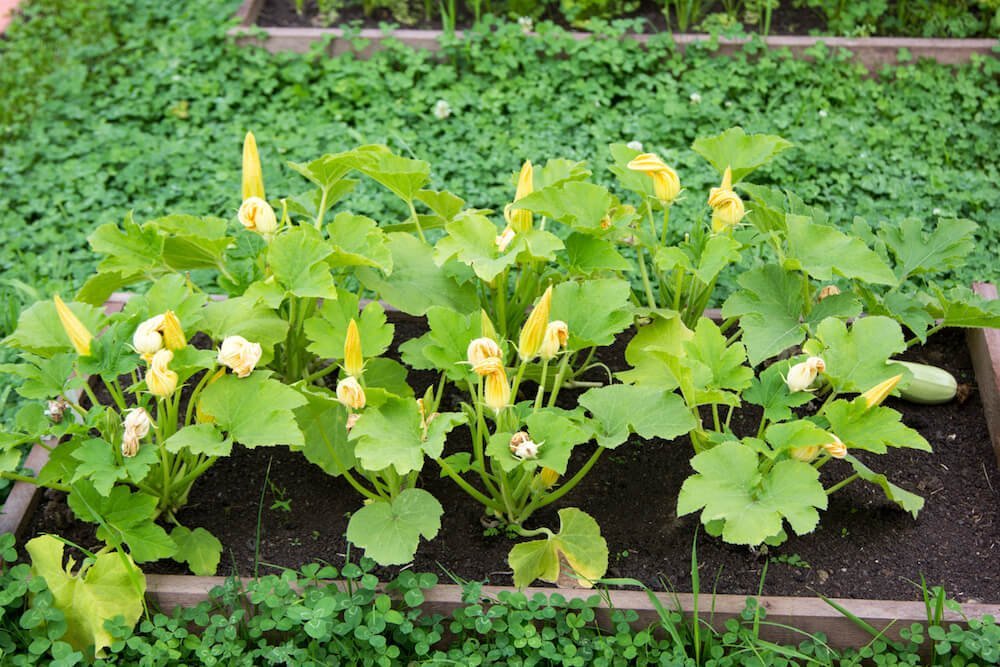
Choosing the Right Location for Your Raised Bed
Considering Sunlight Requirements
When choosing a location for your raised bed, it is crucial to consider the sunlight requirements of zucchini plants. Zucchini plants require full sun, which means they need at least six to eight hours of direct sunlight daily. Ensure that the location you choose for your raised bed provides ample sunlight throughout the day. This will help your zucchini plants thrive and produce an abundant harvest.
Ensuring Proper Drainage
Another important factor to consider when selecting the location for your raised bed is the drainage. Zucchini plants prefer well-draining soil to prevent waterlogged roots, which can lead to diseases and stunted growth. Choose a spot that naturally drains well and avoid areas that tend to retain water, such as low-lying spots or areas with heavy clay soil. Good drainage is crucial for the overall health and success of your zucchini plants.
Maintaining Adequate Air Circulation
Adequate air circulation is essential for preventing fungal diseases and promoting healthy growth in zucchini plants. When choosing the location for your raised bed, consider the surrounding environment and the potential for air circulation. Avoid placing the raised bed in areas that are enclosed or obstructed, such as against a wall or surrounded by tall plants. Opt for an open area that allows for proper airflow to ensure the longevity and vigor of your zucchini plants.
Preparing the Soil in Your Raised Bed
Clearing the Area
Before preparing the soil in your raised bed, it is important to clear the area of any existing vegetation or debris. Remove weeds, rocks, and other unwanted materials that may hinder the growth of your zucchini plants. This will provide a clean slate for your garden and prevent competition for nutrients and sunlight.
Amending the Soil
To create a nutrient-rich environment for your zucchini plants, it is necessary to amend the soil in your raised bed. Start by testing the soil to determine its pH level and nutrient content. This information will guide you in selecting the appropriate amendments for your soil. Common soil amendments for zucchini plants include compost, well-rotted manure, and organic fertilizers. Mix these amendments into the existing soil to improve its structure and fertility.
Testing the Soil pH
Soil pH plays a crucial role in the success of your zucchini plants. Zucchini prefers a slightly acidic to neutral pH range of 6.0 to 7.0. Use a soil testing kit to determine the pH level of your soil. If the pH is outside the optimal range, you can adjust it by adding amendments such as lime to raise the pH or sulfur to lower it. Maintaining the correct soil pH will ensure that your zucchini plants can absorb essential nutrients effectively.
Adding Organic Matter
In addition to amending the soil, adding organic matter is beneficial for the overall health and fertility of your raised bed. Organic matter, such as compost or aged manure, improves soil structure, moisture retention, and nutrient availability. Spread a layer of organic matter over the soil surface and gently work it into the top few inches of soil. This will provide a nutrient boost and enhance the long-term health of your zucchini plants.
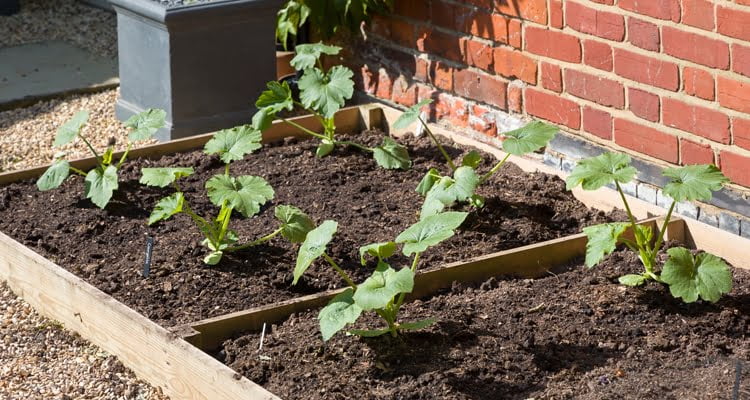
Selecting and Planting Zucchini Varieties
Choosing the Right Zucchini Variety
When it comes to selecting the right zucchini variety for your raised bed, consider factors such as space availability, yield, and disease resistance. There are various zucchini varieties available, ranging from compact bush types to sprawling vining types. Compact varieties are suitable for smaller raised beds or containers, while vining varieties require more space to spread out. Additionally, choose disease-resistant varieties to minimize the risk of common zucchini diseases.
Starting Seeds Indoors
To get a head start on the growing season, you can start zucchini seeds indoors before transplanting them into your raised bed. Start the seeds indoors about four to six weeks before the last expected frost date in your area. Fill seed trays or pots with seed-starting mix and plant the zucchini seeds according to the package instructions. Place the trays in a warm and bright location, ensuring that the soil remains moist. Once the seedlings have developed a few true leaves, they are ready for transplanting.
Transplanting Seedlings
When the threat of frost has passed and the soil has warmed up, it is time to transplant your zucchini seedlings into the raised bed. Before transplanting, harden off the seedlings by gradually exposing them to outdoor conditions over the course of a week. Dig holes in the prepared soil, spacing them according to the recommendations for your chosen zucchini variety. Carefully remove the seedlings from the seed trays, gently untangle their roots, and place them in the holes. Backfill the soil around the seedlings and water thoroughly.
Direct Sowing Seeds
Alternatively, you can sow zucchini seeds directly into the soil in your raised bed. Wait until all danger of frost has passed and the soil has warmed up to at least 60°F (15°C) before sowing the seeds. Make shallow furrows in the soil, spaced according to the recommendations for your chosen zucchini variety. Plant the seeds at the appropriate depth, typically around half an inch deep. Cover the seeds with soil, water gently, and keep the soil consistently moist until the seeds germinate.
Caring for Zucchini Plants in a Raised Bed
Providing Regular Watering
One of the key aspects of caring for zucchini plants in a raised bed is providing regular watering. Zucchini plants require consistent moisture, especially during hot and dry periods. Irrigate the raised bed deeply, ensuring that the water reaches the roots. Avoid overhead watering, as wet foliage can encourage diseases. To maintain proper soil moisture, consider using a drip irrigation system or soaker hoses. Monitor the soil moisture regularly and adjust the watering schedule as needed.
Implementing Mulching Techniques
Mulching is a beneficial practice for zucchini plants in a raised bed. Mulch helps to suppress weeds, conserve soil moisture, and regulate soil temperature. Apply a layer of organic mulch, such as straw or shredded leaves, around the base of the zucchini plants, being careful not to smother the stems. This will help suppress weed growth and reduce the need for excessive watering. Additionally, the mulch will break down over time, enriching the soil with organic matter.
Supporting the Plants
As zucchini plants grow, they can become heavy and require support to prevent sprawling and breakage. Use stakes, trellises, or cages to provide support for the plants. Insert the supports into the soil near the base of each plant, being careful not to damage the roots. Secure the plants to the supports with soft twine or plant ties as they grow taller. Supporting the plants will keep them upright, improve air circulation, and make it easier to harvest the zucchini.
Pruning Zucchini Plants
Pruning zucchini plants can help promote better airflow and prevent overcrowding in the raised bed. Prune off any damaged or diseased leaves or branches as soon as you notice them. Additionally, you can selectively prune excessive foliage to improve light penetration and airflow. However, be cautious not to remove too much foliage, as the leaves play a crucial role in photosynthesis. Regular pruning and maintenance will help keep your zucchini plants healthy and productive.
Fertilizing the Soil
To ensure optimal growth and yield, it is important to provide adequate nutrients to your zucchini plants. Incorporate a balanced slow-release fertilizer into the soil at the time of planting or use liquid fertilizers throughout the growing season. Follow the package instructions for application rates and timings. Additionally, consider periodic side-dressing with compost or organic fertilizers to provide a continuous supply of nutrients. Regular fertilization will promote vigorous growth and abundant zucchini production.
Monitoring for Pests and Diseases
As with any garden plants, zucchini plants are susceptible to pests and diseases. Monitor your plants regularly for common pests such as aphids, squash bugs, and cucumber beetles. If you notice any signs of infestation, take appropriate measures, such as handpicking pests or using organic insecticides. Similarly, be vigilant for signs of diseases like powdery mildew or blossom end rot. Provide adequate air circulation, avoid overwatering, and promptly remove any infected plant material to prevent the spread of diseases.
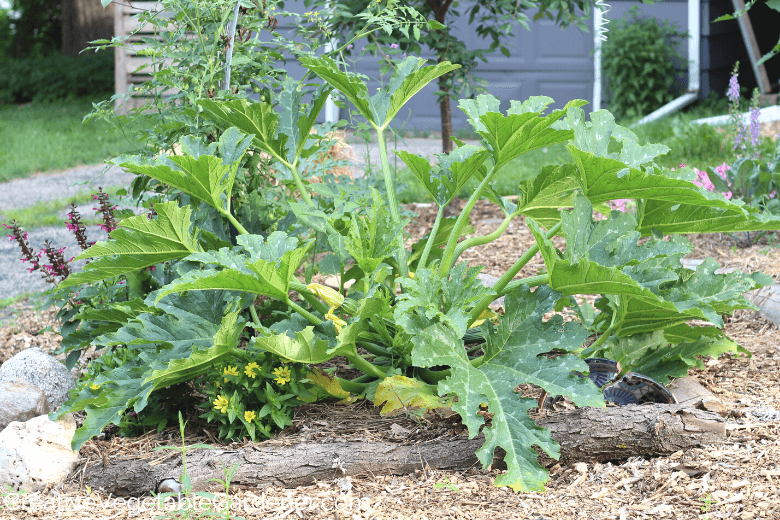
Harvesting and Storing Zucchini
Knowing When to Harvest
Knowing when to harvest your zucchini is essential for enjoying it at its peak flavor and texture. Zucchini should be harvested when it reaches a length of around 6 to 8 inches and a diameter of 1 to 2 inches. The skin should be firm and glossy, with no signs of softening or wrinkling. Harvesting zucchini at this stage ensures that they are tender and flavorful. If left on the plant for too long, zucchini can become overgrown and develop a woody texture.
Harvesting Zucchini Properly
To harvest zucchini properly, use a sharp knife or pruning shears to cut the fruit from the plant, leaving a short stem attached. Avoid twisting or pulling the zucchini, as this can damage the plant. Be gentle when handling the zucchini to prevent any bruising or damage. Place the harvested zucchini into a shallow basket or container to prevent them from getting crushed. Harvesting regularly encourages the plant to continue producing more fruit throughout the season.
Storing Zucchini
If you have harvested more zucchini than you can consume immediately, storing it correctly will help prolong its freshness. Zucchini can be stored in the refrigerator for up to one week. Place the unwashed zucchini in a perforated plastic bag or a loosely sealed plastic container to allow for airflow. Avoid washing the zucchini before storage, as excess moisture can cause it to spoil more quickly. For longer-term storage, consider freezing or preserving zucchini through canning or pickling methods.
Preserving Zucchini
Preserving zucchini is a great way to enjoy its abundance throughout the year. There are several methods you can use to preserve zucchini, including freezing, canning, and pickling. To freeze zucchini, blanch it in boiling water for a few minutes, then plunge it into ice water to stop the cooking process. Drain and dry the zucchini before packaging it in an airtight container or freezer bags. For canning and pickling, follow safe food preservation guidelines and recipes to ensure the quality and safety of the preserved zucchini.
Common Issues and Troubleshooting
Powdery Mildew
Powdery mildew is a common fungal disease that affects zucchini plants. It appears as a white powdery coating on the leaves, which can eventually cause them to turn yellow and die. To prevent powdery mildew, ensure adequate air circulation and avoid overhead watering. If powdery mildew appears, remove and destroy infected leaves and consider applying an organic fungicide specifically formulated for powdery mildew control.
Blossom End Rot
Blossom end rot is a disorder characterized by a dark, sunken spot on the blossom end of the zucchini fruit. It is caused by a calcium deficiency and is often exacerbated by irregular watering. To prevent blossom end rot, maintain consistent soil moisture and ensure adequate calcium availability. Adding organic matter to the soil and using mulch to conserve moisture can help prevent this issue.
Squash Vine Borer
Squash vine borers are destructive pests that can decimate zucchini plants. They burrow into the stems of the plants, causing wilting, yellowing, and eventually plant death. To prevent squash vine borers, cover the base of the plants with floating row covers or aluminum foil at the time of planting to restrict access for the adult borers. Monitoring the plants regularly for signs of infestation and removing any eggs or larvae you find can also help control this pest.
Fruit Set Problems
Sometimes zucchini plants may set fewer fruits than expected, or the fruits may fail to develop fully. This can be due to various factors, including poor pollination, extreme temperatures, or nutrient deficiencies. To improve fruit set, encourage pollination by providing a pollinator-friendly environment, such as planting flowers that attract bees nearby. Maintaining consistent soil moisture and nutrient levels can also promote healthy fruit development.

Companion Planting for Zucchini in a Raised Bed
Beneficial Companion Plants
Companion planting can help improve the overall health and productivity of zucchini plants in a raised bed. Beneficial companion plants for zucchini include herbs such as dill, oregano, and basil, which can repel pests and attract pollinators. Additionally, planting marigolds or nasturtiums near the zucchini plants can help deter pests and attract beneficial insects. These companions can create a diverse and balanced ecosystem in your raised bed, promoting the growth and well-being of your zucchini plants.
Detrimental Companion Plants
While there are many beneficial companion plants for zucchini, it is important to be aware of some detrimental companions that may hinder zucchini growth. Avoid planting zucchini next to other members of the cucurbit family, such as cucumbers, melons, and squash. These plants are susceptible to the same diseases and pests, and planting them together increases the risk of cross-contamination. Rotate your crops each year to prevent the build-up of pests and diseases in your raised bed.
Extending the Growing Season for Zucchini
Using Season Extenders
If you live in a region with a shorter growing season, you can use various season extenders to prolong the time you can grow zucchini in your raised bed. One option is to use row covers or cold frames to protect the plants from frost and provide a slightly warmer microclimate. Another option is to grow zucchini in containers or pots that can be easily moved indoors when temperatures drop. By using these methods, you can start growing zucchini earlier in the year and continue harvesting later into the fall.
Cool-Season Zucchini Varieties
To extend the growing season for zucchini, consider planting cool-season varieties that are more tolerant of lower temperatures. These varieties can withstand cooler conditions without compromising their growth and productivity. Look for zucchini varieties specifically bred for cool-season or short-season climates. By selecting the right varieties, you can enjoy fresh zucchini even in areas with shorter summers.
Succession Planting
Succession planting is a technique that involves planting new zucchini seedlings or sowing seeds at regular intervals throughout the growing season. By staggering the planting dates, you can ensure a continuous supply of zucchini throughout the season. As one batch of plants starts to decline, the newly planted ones will be ready to take their place. This allows you to maximize your zucchini harvest and enjoy fresh produce over an extended period.
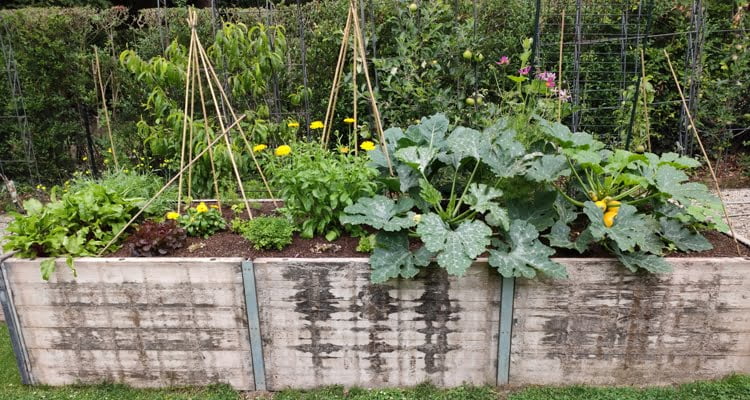
Harvesting Zucchini Flowers for Culinary Purposes
Edible Zucchini Flowers
Zucchini flowers are not only beautiful but also delicious and versatile in the kitchen. Both male and female zucchini flowers are edible, but it is important to harvest them at the appropriate time. Male flowers do not produce fruit and can be harvested without affecting the plant’s productivity. Female flowers, on the other hand, develop into zucchini, so it is best to harvest them sparingly to allow for fruit set.
Harvesting Male and Female Flowers
To harvest zucchini flowers, simply pinch off the male flowers close to the base of the stem. Leave a short stem intact to hold the petals together. Female flowers can also be harvested, but ensure that there are enough remaining female flowers for pollination and fruit production. Harvest flowers in the early morning when they are fully open and at their freshest.
Preparing and Cooking Zucchini Flowers
Zucchini flowers can be used in various culinary preparations, both sweet and savory. They can be stuffed with cheese or other fillings and lightly sautéed or battered and fried. Alternatively, you can chop the flowers and incorporate them into salads, omelets, or pasta dishes. The delicate and subtly sweet flavor of zucchini flowers adds a unique touch to any dish. Experiment with different recipes and enjoy the culinary delights that zucchini flowers have to offer.
Troubleshooting Common Raised Bed Challenges
Weed Control
Weed control is an ongoing challenge in any garden, including a raised bed. To prevent weeds from taking over your raised bed, implement good weed management practices. Start by removing any existing weeds before planting your zucchini. Mulch the soil surface with organic mulch to suppress weed growth and prevent new weed seeds from germinating. Regularly inspect your raised bed and manually remove any emerging weeds. By staying on top of weed control, you can minimize competition for resources and ensure the optimal growth of your zucchini plants.
Soil Nutrient Imbalance
Maintaining the proper balance of nutrients in the soil is crucial for the overall health and productivity of your zucchini plants. Imbalances in soil nutrients can result in stunted growth or nutrient deficiencies in the plants. Regularly test your soil to determine its nutrient content and pH levels. Based on the results, adjust the soil amendments and fertilizers accordingly to provide the necessary nutrients. Monitoring the condition of your zucchini plants and addressing any signs of nutrient deficiencies or imbalances promptly will help ensure their successful growth.
Watering Issues
Watering issues can arise in a raised bed, leading to either under or overwatering of your zucchini plants. Too little water can cause wilting, stunted growth, and poor fruit set. On the other hand, excessive watering can lead to root rot and other diseases. To avoid watering issues, monitor the soil moisture regularly and adjust the watering accordingly. The soil should be consistently moist but not soggy. Consider using drip irrigation or soaker hoses to provide a steady and controlled water supply to your zucchini plants.
In conclusion, growing zucchini in a raised bed can be a rewarding experience. By selecting the right location, preparing the soil properly, choosing the appropriate zucchini varieties, and implementing proper care techniques, you can enjoy a bountiful harvest of fresh zucchini throughout the growing season. Remember to monitor for pests and diseases, harvest at the right time, and experiment with different culinary uses for zucchini flowers. With a little attention and care, your raised bed can be a thriving zucchini garden. Happy growing!
